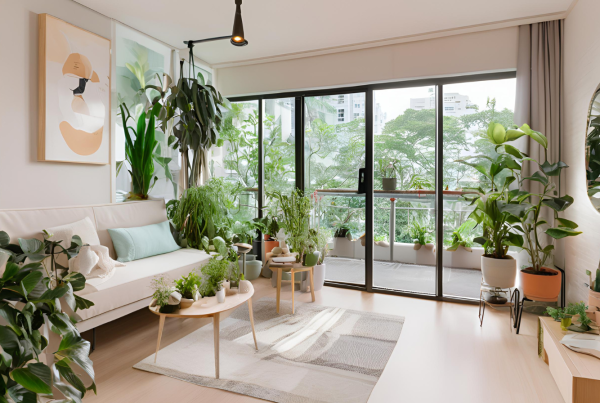Maximizing space in a small condos in Singapore is not just about making it look good; it’s about ensuring comfort and functionality in a limited area. Strategic planning and design choices play a pivotal role in achieving this delicate balance, influencing how spacious your living area feels and functions.
The average size of studios and small condos in Singapore is notably smaller compared to many other parts of the world. Here’s a table summarizing the typical sizes:
| Location | Studio | 1-Bedroom | 2-Bedroom |
|---|---|---|---|
| Singapore | 300-450 sq ft (27.9-41.8 sq m) | 400-550 sq ft (37.2-51.1 sq m) | 600-850 sq ft (55.7-79.0 sq m) |
| United States | 400-600 sq ft (37.2-55.7 sq m) | 600-800 sq ft (55.7-74.3 sq m) | 900-1200 sq ft (83.6-111.5 sq m) |
| Australia | 40-50 sq m (430-538 sq ft) | 50-70 sq m (538-753 sq ft) | 70-100 sq m (753-1076 sq ft) |
| United Kingdom | 30-40 sq m (323-430 sq ft) | 40-50 sq m (430-538 sq ft) | 50-60 sq m (538-646 sq ft) |
These size variations highlight the unique challenges and opportunities presented by small apartment living in Singapore compared to other regions. Effective space-maximizing strategies tailored to Singapore’s context can help residents make the most of their compact living spaces while maintaining comfort and functionality.
Tips to Maximise Space of Small Condos in Singapore
One key strategy in maximizing space in small apartments in Singapore is to avoid installing false ceilings, despite their potential benefits for concealing wiring and improving aesthetics. While false ceilings may seem appealing, particularly for their ability to create a polished look and hide unsightly elements, they can have drawbacks, especially in apartments with low ceilings. False ceilings have the unintended effect of reducing the perceived height of the room, making the space feel more cramped and confined. Moreover, false ceilings can pose maintenance challenges, as they can become breeding grounds for dust and pests if not properly maintained. In Singapore’s humid climate, moisture accumulation within the enclosed space above false ceilings can exacerbate these issues, leading to potential health hazards and increased cleaning efforts.
Another effective approach involves embracing light colors for your interior decor. By opting for neutral color schemes, you can infuse your space with brightness and create an illusion of airiness. This simple yet powerful design principle helps prevent visual clutter, making the room feel more expansive—a particularly advantageous strategy in small Singapore apartments where natural light is limited. Keep window treatments minimal to allow natural light to flood into your apartment, which creates a sense of openness and airiness. Mirrors can also be strategically placed to reflect light and make the space feel larger.
Compartmentalization plays a vital role in optimizing the functionality of a small living space. By dividing the area into multifunctional zones with clear boundaries, you can effectively minimize clutter and improve overall organization. Thoughtfully placing furniture and decor elements assists in delineating these zones, allowing you to make the most of every available inch of space within the apartment. Creating distinct areas for various activities, such as living, dining, and working, helps to maximize the functionality of the apartment. For example, you can use area rugs, furniture arrangement, or room dividers to establish separate zones without sacrificing the sense of openness. Strategic placement of storage solutions, such as built-in cabinets, floating shelves, or under-stair storage, further enhances compartmentalization and maximizes the use of vertical space. By keeping items neatly organized and out of sight, you can maintain a clutter-free environment and create a more visually appealing living space.
Keep window treatments minimal to allow natural light to flood into your apartment, which creates a sense of openness and airiness. Mirrors can also be strategically placed to reflect light and make the space feel larger. Introducing architectural elements like glass walls can visually expand the space while maintaining connectivity. Glass partitions allow light to permeate throughout the apartment, fostering a sense of openness and cohesion. This design strategy is especially beneficial in Singapore’s compact apartments, where traditional walls can contribute to a feeling of confinement.
Adopting an open-concept layout can significantly enhance the spatial flow and flexibility of your living space. By removing non-structural walls, you can create a seamless transition between different areas within the apartment, fostering a sense of openness and cohesion. This design choice can make the space feel more substantial and allow for greater flexibility in furniture arrangement and usage. However, it’s essential to carefully weigh the benefits against potential drawbacks, such as privacy concerns and renovation costs. While an open-concept layout can promote a more spacious and interconnected feel, it may also compromise privacy, especially in areas like bedrooms or home offices. Additionally, renovating to achieve an open-concept design may incur higher costs due to structural changes and additional design considerations. Therefore, it’s important to consider these factors carefully and consult with professionals to determine the best approach for your specific needs and preferences.
Opt for furniture pieces that serve multiple purposes, such as a sofa bed or a coffee table with built-in storage. This allows you to maximize functionality while minimizing clutter. Install shelves or wall-mounted storage units to make use of vertical space for storing items and keeping surfaces clear. Vertical storage helps free up valuable floor space in small apartments. Opt for furniture with exposed legs to create a sense of visual space. Sleek, slender pieces allow light to pass through, adding to the feeling of openness and airiness. By selecting minimalist designs, you can achieve a streamlined aesthetic while maximizing perceived spaciousness.
In the bedroom, prioritizing functionality is key to making the most of limited space. Platform beds with integrated storage solutions offer an excellent way to maximize storage capacity while maintaining style and comfort. These space-saving furniture pieces often feature drawers or compartments built directly into the bed frame, providing convenient storage for bedding, clothing, or other personal items. Additionally, getting creative with storage solutions can further help keep clutter at bay in the bedroom. Consider utilizing under-bed storage bins or boxes to store seasonal clothing, extra linens, or shoes. Benches or ottomans with hidden storage compartments can serve as both seating and storage space, while coffee tables with built-in shelves or drawers offer a stylish way to keep essentials within easy reach.
When planning the kitchen layout, opting for an open-concept design can amplify the feeling of space and connection throughout the apartment. However, it’s important to consider the potential issue of cooking fumes spreading into living areas. Therefore, it’s crucial to have adequate ventilation solutions in place to address this concern. Additionally, maximize storage space in the kitchen by utilizing stackable containers, hanging racks, and magnetic spice holders. These storage solutions help keep the kitchen organized and clutter-free, optimizing the available space effectively.
By implementing these design strategies and space-saving solutions, you can transform your small Singapore apartment into a comfortable and inviting living space. With careful planning and creativity, you can make the most of your limited square footage while enhancing functionality and aesthetic appeal.







